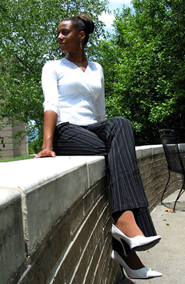FLOWOOD, Miss.—Ever since her lower legs were amputated as a baby, Tammy Stamps of Brandon had been stuck with two styles of footwear for her artificial feet—tennis shoes or flats.
So when she got her first pair of high heels at age 16, Stamps happily strutted down the hallway at Methodist Orthotics and Prosthetics in Flowood like she was prancing down a fashion show runway. “I just got in them and kept ticking,” she said.
The moment was a highlight for Methodist staff, who know all too well the challenges facing kids who grow up with artificial limbs. Taking someone from baby shoes to high heels requires a constant monitoring of fit, function, and in Stamps’ case, even fashion.
When Stamps indicated an interest in modeling, she was fitted with a new pair of feet that could be adjusted to accommodate shoes of varying heel heights. “Methodist was the first company that satisfied her,” said her mom Bobbie Stamps. “She said she found somebody who would work along with her.”
Chris Wallace, director of Methodist Orthotics and Prosthetics, says that meeting the prosthetic needs of children and adolescents can be complicated because of growth issues. “You’re mainly trying to keep up with length changes,” he said.
Manufacturers have addressed that problem by building components with “growing room.” But they’re still struggling with how to make them more “child-proof.” Wallace said youngsters are notoriously tough on their equipment. “We say they can tear up a crowbar with a rubber hammer. They are just so active.”
Stamps said she once broke off a foot while playing basketball with a bunch of boys. “I was a tomboy and I didn’t let anything stop me,” she said. “I was in the dirt or in the pool or I was throwing my legs and hitting people with them.”
A circulation problem that led to gangrene forced the amputation of Stamps’ legs at about age 3 months. And until age 3—when her mom cajoled her into learning to walk with artificial legs—the tot mostly made do without her prostheses. “I didn’t like wearing them,” Stamps said. “I crawled around on my knees most of the time.”
Wallace said since the days when Stamps was a baby, the prosthetic industry has made great strides in improving equipment designs for those who are too young to understand how to use their prostheses. “One company has a hand that automatically opens when you reach for something and closes when you grab it,” he said.
Another advance is myolectric controls that can be attached to a child’s residual arm and used to operate a remote control car or a video game. Wallace said this offers a fun way for kids to practice the skills they’ll need to eventually operate a prosthetic hand.
While all prosthetic users heavily depend on the functionality of their equipment, aesthetics and style have become increasingly important, too. Toddlers, for instance, can now choose components that feature favorite characters such as Bob the Builder, Cinderella and Winnie the Pooh.
“We also have NFL teams, trucks and planes. And kids can bring in their own fabrics and we can build with that,” Wallace said. “We have one kid who has a glow-in-the-dark Superman. We can do things like that on braces, as well.”
While young kids today often choose designs that call attention to their prostheses, Stamps said she always wanted hers to “look real.” To that end, Methodist staff matched her prosthetic covers to her skin tone, creating legs so lifelike that Stamps has worn them in modeling auditions and no one was the wiser.
Stamps, now 19, said she’s interested in finding a career where she can combine her love for makeup, shoes, fashion and business. And she also hopes to “help little kids in the same situation as me.”
For now, though, she’s enjoying her break away from school and indulging one of her favorite pastimes—shopping for Size 6 shoes. (Stamps said she picked Size 6 feet—a common size for sample shoes—so that she could find more selection on the clearance racks.)
“At Designer Shoe Palace, they see me coming and kind of cater to me,” she said. “Now I’ve got heels that start out at 2 inches and go to 6 ½ inches. I’ve even got some boots that come up to my thighs.”
Methodist Orthotics and Prosthetics, a division of Methodist Rehabilitation Center in Jackson, Miss., was one of the first sites in the nation to fit amputees with the Otto Bock C-Leg—the world’s first completely microprocessor-controlled artificial leg. The division is recognized by the American Board of Certification as a center of excellence. Methodist Orthotics and Prosthetics has clinics in Flowood, Hattiesburg and Monroe, La.

